2022.1 Release (version 1.5.0)🔗
Release 2022.1 (version 1.5.0)
General availability: Customer managed 2022-FEB-15 | Desktop 2022-FEB-15
Welcome to the Modelon Impact 2022.1 release. Since the release of Modelon Impact, we’ve made constant enhancements to user productivity and experience. With this 2022.1 release, system simulation just got a lot more powerful with Modelon Impact Customer managed, a deployment target for on-premises and private cloud.
Below includes a detailed list of updated and new features in Modelon Impact and Modelon Library Suite.
Selected Highlights🔗
Build🔗
- 3rd Party Libraries: Modelica Standard Library 4.0
- Modelon Libraries: Quick-Start Industry Examples Package
- Modelon Libraries: Air Conditioning Library Now Available
- Modelon Libraries: Strong Focus on Hydrogen
- Modelon Libraries: Electrification In Energy Industry
- Modelon Libraries: Table-Based Media Database
- Modelon Libraries: Steady-State Vehicle Dynamic Analysis
- Model Code View: Integrated code editor
- Model Debug: Compiler Error Message With Link To Source of Error
- Model Debug: Integrated log viewer
Analyze🔗
Collaborate🔗
- Cloud Access: Modelon Impact Customer managed
- Version Control: Connect Project From SVN and GIT
- Python Client: Customizable Multi Execution Workflow-
Learn🔗
Build: Model Builder🔗
Model Code View - Integrated Modelica Code-Editor🔗
Be more productive authoring models with the following improvements:
Integrated Modelica Code-Editor
The Modelica code editor is now fully integrated into the UI. Users that author Modelica code can now navigate quickly between models and use the library browser. Additional improvements include:
- Automatic save and syntax check
- Menu with shortcuts
Modelica code layer interface
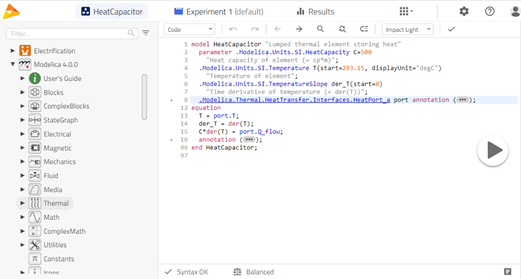
Model Debug🔗
There has been a focused effort in improving the user experience and providing tools to help you with model and simulation diagnostics. The following improvements include:
Compiler Error Message With Link To Source of Error
You can now click on a link to go to the source of error at compilation failure. The link will take you to and highlight the line causing the error.
Compiler Error Message

Integrated Log Viewer
View simulation and compilation logs while simultaneously inspecting or editing a model. Access the integrated log viewer from the log button at the bottom of the model canvas. Logs can now be downloaded.
Log viewer
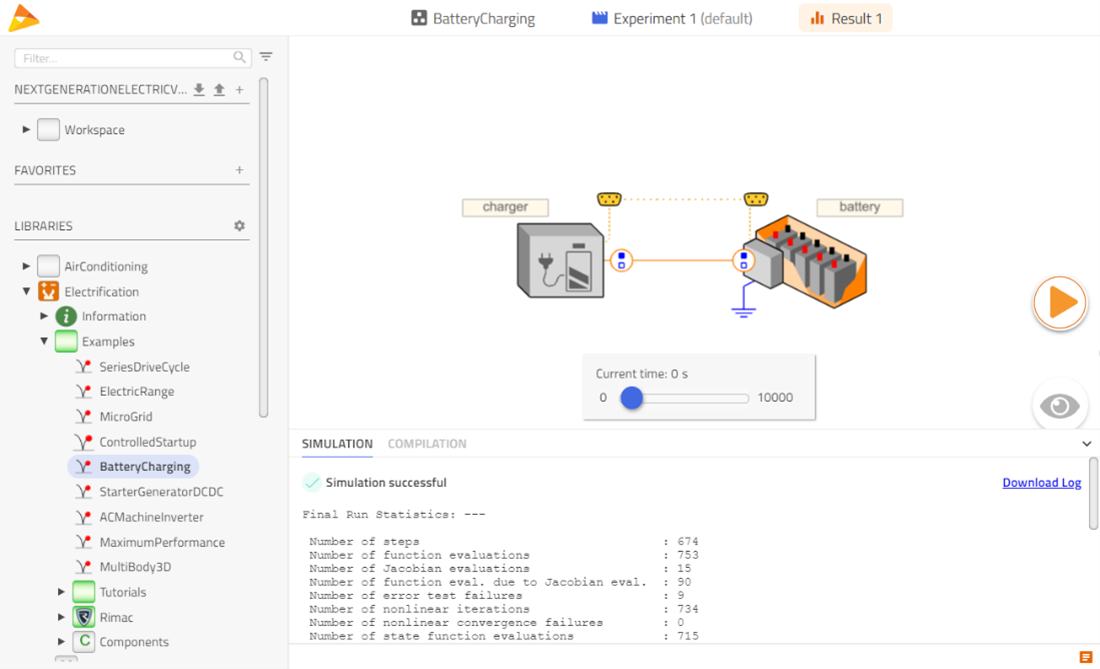
Model Statistics
There has been a redesign of how model statistics are presented. You can quickly get an overview of the model structure and equations systems.
Model Statistics

Solver Diagnostics in Result-File
You can now include solver diagnostics in the result file and use the standard plotting functionalities to investigate why a simulation is running slowly. Examples of what you can plot are CPU time, number of solver steps, number of events, and state that limits step size.
Solver diagnostics
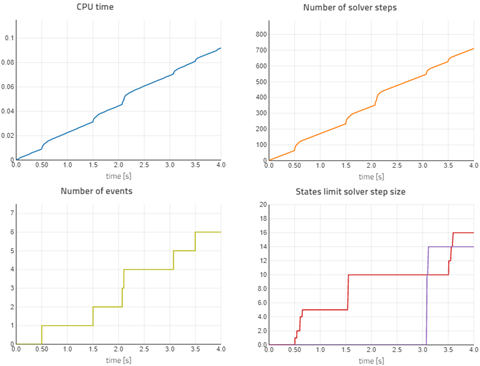
Steady-State Simulation Specific Improvements
You can now plot the last value of a failed converged steady-state simulation and get information about the iteration variables and residual equations in the simulation log. This information may help you gain insight into why a simulation failed.
Simulation log
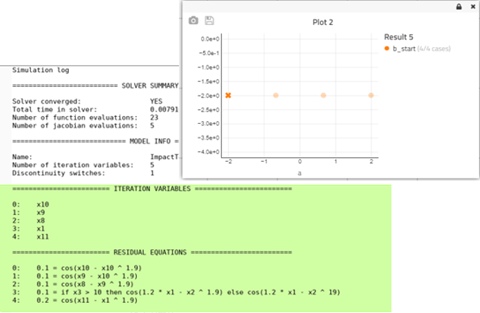
Additional Error Checking in Local Checker
The local error balance checker includes now additional checks including (missing declarations, type checking etc).
Access HTML diagnostics on a per-FMU basis
HTML diagnostics are now saved within each FMU folder on disk (previously only the latest FMU's diagnostics were saved)
Model Diagram View🔗
- Show model name in tab - easier to work with multiple tabs as the model name is displayed on the tab
-
Keyboard shortcuts
- 1, 2, and 3 to navigate between Modeling, Experiments, & Result mode
- Ctrl++, Ctrl -- to Zoom in/out in diagram and 3d viewer
-
Feedback on loading progress
- Improved handling of inactivity and server reconnect
Parameter Dialog - Import Data from Excel🔗
It’s now possible to copy data from Excel into a model. A common use case is to parametrize a table.
Import data from Excel
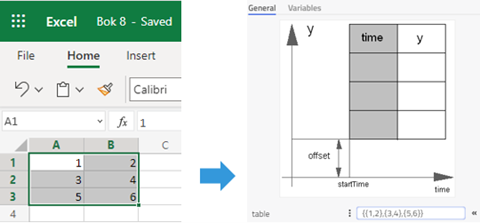
- Excel: Select and Copy matrix
- Modelon Impact: Select matrix in a model and Paste
Workspace Browser🔗
Faster loading time of editable libraries
Meta-data for editable libraries are now cached which significantly reduces the loading time when working with large libraries.
Re-Ordering of Models
Customize the order of appearance of models within a package. A common use case is to move commonly used models to the top for quicker access.
- Drag and drop a class in the library browser to change the order of appearance
- Graphical indication during drag and drop shows where the class will be placed
Re-Ordering of Models
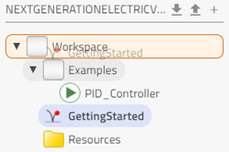
Renaming of a top-level class
- It’s now possible to rename a top-level class (which was previously only available from code editor)
Create all types of classes
- Create all types of classes from the new model dialog. Now with support for common options such as function and connector
Duplicating a sub-package now retains the file structure (i.e. individual files)
File watcher enhancements
- Read-only folder is now under the file watcher
- Ignore capability (impact.ignore). Similar to .gitignore, adding it to the workspace directory restricts the file watcher from firing events on irrelevant changes defined in the ignore file.
Delete workspaces
- UI support to delete a workspace from the settings panel
Center library tree around an opened model
- Opening a class will automatically center that class in the library browser
Build: Libraries🔗
3rd party libraries - Modelica Standard Library 4.0🔗
Modelon Impact has now upgraded the default version of Modelica Standard Library to 4.0* (the latest version). With MSL 4.0 users can take advantage of the latest improvements (including new libraries ). Users can choose if they want to automatically upgrade or stay on the previous version of the Modelica Standard Library.
*The sub package Modelica.Clocked is not yet supported and is therefore not included in the distributed MSL 4 version.
Modelon libraries - New Industry Examples Library🔗
Start with this collection of industry vertical examples and workflows built from Modelon Libraries.
- Dedicated to all new and existing users allowing them to find, run, and use highly relevant examples and workflows
- Divided into different industries with verticals, as sub-packages
Industry Example Package structure
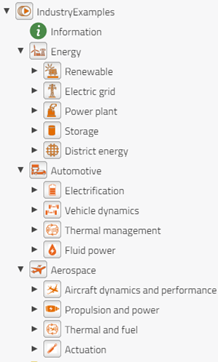
- Common place for storing Modelon cross-library examples and workflows showing the best practices for different Modelon libraries connections
Industry Examples model solar power Tower
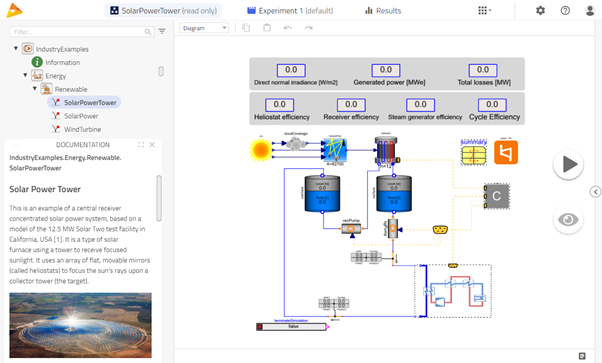
- Presenting examples that are relevant for different user groups
Modelon libraries - Air Conditioning Library Now Available🔗
Modelon’s Air Conditioning Library is now integrated and accessible in Modelon Impact. Users will be able to access Modelon’s world-class comprehensive library to design, analyze, and optimize automotive air conditioning systems. Read more in this blog.
Air Conditioning library model

Automotive - Steady-State Vehicle Dynamic Analysis🔗
Full fidelity vehicle chassis analysis using multi-run and a steady-state solver allows for efficient suspension system design.
- Perform a quasi-static analysis where a car is taken through different speeds and levels of lateral accelerations to analyse how the forces are distributed over axles
- Diagram the required steering wheel angle to maintain a given level of lateral acceleration
Steady-state vehicle dynamic analysis
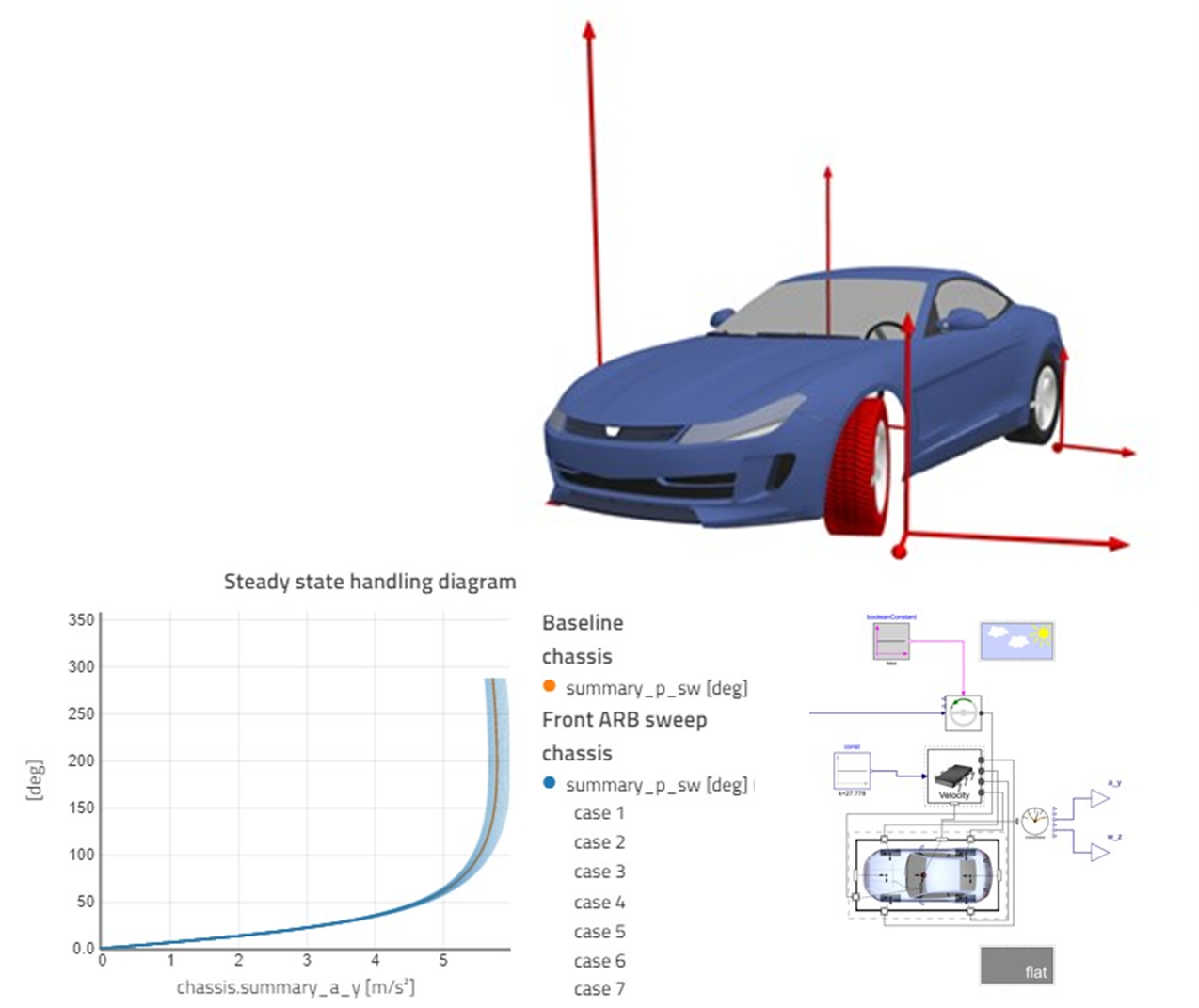
- Dynamic frequency response shows how the vehicle will respond to steering inputs of different frequencies
- Perform a simple step steer test at a given speed to evaluate different motion states of a vehicle
Energy, Air conditioning and Refrigeration🔗
Strong Focus on Hydrogen
New hydrogen green-energy focused models allow simulations to generate hydrogen from water via electrolysis, store it in a tank, and generate electricity when needed by fuel cells.
- Thermal Power Library is enhanced by a new Hydrogen Package allowing the creation, storage, and usage of hydrogen as an energy storage media
Strong Focus on Hydrogen

- Modelon’s Fuel Cell Library is enhanced by a New Ejector/Pump model, Humidifier models, fidelity improvements, and realistic default parameters
Electrification In Energy Industry
Power grids are facing a major transformation, driven by the need to integrate renewable energy. A grid-connected system can power homes or small businesses with renewable energy during those periods (daily as well as seasonally). Energy is generated when the sun is shining, the water is running, or the wind is blowing. Additionally, energy can be stored in batteries for later usage. Any excess electricity produced is fed back into the grid.
- Renewable energy with inverters and a power grid is connected to a consumer which is additionally connected to the electrical power grid.
Table-Based Media Database
The spline-based table-lookup media SBTL created by Modelon presents an alternative way to implement a media to that of a full or short Helmholtz two-phase media implementation.
- The SBTL media is based on coefficient-driven look-up tables, which describe the media properties
- Simulation is much faster compared to the Helmholtz approach which calculates (interpolates) the media properties
- Increased speed is achieved by fast access to pre-calculated properties defined in the spline coefficient tables
- Spline coefficient tables are loaded as external objects at the initialization of a simulation
| Media | Usage & Comments |
|---|---|
| Helium | Widely used for its inert nature in super-cooling and cryogenics technologies |
| R22 (Freon) | Even banned media it is still used for comparison with the new media |
| n-Pentane | User as a working medium in geothermal plants |
| HFE-7000 | Modern Refrigerant and heat-transfer fluid |
| R134a and R1234y | Widely used as an automotive refrigeration medium |
| CO2 | Modern high-pressure refrigerant used in all industries |
Analyze: Experiment Builder🔗
- Explicit default experiments - set an experiment as default
Analyze: Solver🔗
Custom functions🔗
Clickable Links to Uploaded Artefacts
Upload a report or file from a custom function and add a clickable link to it in the simulation log.
- Use a markdown-like pattern to indicate the link in the custom function
- Html reports are opened in a new tab and files are downloaded
Execution environment🔗
- Python upgrade to 3.9 - (only for Linux)
- OCT Editing API for equations and algorithms – Java API support to add, remove and edit equations
Analyze: Visualization Tools🔗
3D animation🔗
- New playback options (loop option, start & stop time)
- Faster loading of animation view (~30%)
- Improved camera default when a MultiBody.World component is present
- Fit view to individual object by right-clicking on a component in the 3D viewer
- Improved lightning behavior for metallic material
Collaborate: Cloud Access🔗
Browser-based🔗
Configure the browser to launch Modelon Impact (Desktop). New environment variable IMPACT_LAUNCH_IN_BROWSER to be defined to select the browser to open Impact (Chrome is chosen by default)
Customer managed🔗
Introducing Modelon Impact Customer managed. A new solution for on-premise and private cloud.
User and license management🔗
- Identity and Access Management Center (Exclusive for Modelon Impact On-Premise / Private Cloud
Collaborate: Integrations🔗
Apps🔗
-
UI menu for apps
- Webapps moved to the new Customizations Menu in the toolbar
- Support for adding categories
Jupyter🔗
- Create & run Notebooks using 3rd party plugin JupyterLab (Exclusive for Modelon Impact On-premise / Private cloud)
Python client🔗
Customizable Multi-run Workflow
The REST-API and the corresponding Python client have been updated to efficiently support multi-run workflows that require updates and re-execution of cases. More specifically, you can now programmatically use the Python client to:
- Add metadata to an experiment
- Run a batch simulation
- Inspect results in UI (including failed cases)
- Update failed cases to initialize from a successful case
- Only re-run the failed cases
Python client

Collaborate: Workspace🔗
External Version Control Connection🔗
From the new Workspace configurator app:
Repository Management
- Manage your version-controlled model repositories
- Model libraries are automatically detected and presented in the user interface
- Use basic version control operations to stay in sync with your colleagues. For advanced operations, a 3rd party plugin can be used.
Repository Management
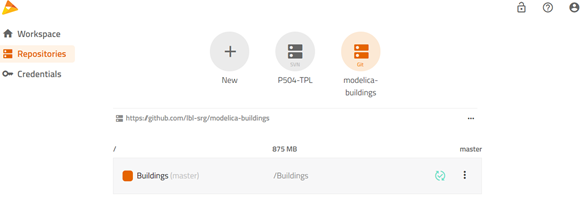
Connect Projects From SVN and GIT
Modelon Impact allows users to collaborate with other users via version-controlled repositories on Subversion (SVN) and Git. This enables the use of version-controlled Modelica libraries in Modelon Impact workspaces, and changes and new contributions to these libraries are tracked and can be shared with others through version-control operations built into the app.
- Updates by other users can also be fetched, enabling coordinated work among Modelon Impact users collaboratively developing models or Modelica libraries.
Workspace Configuration🔗
Collaborate and manage model repositories and libraries from a dedicated user interface using the new workspace management app (exclusive for Modelon Impact On-Premise).
Workspace management app
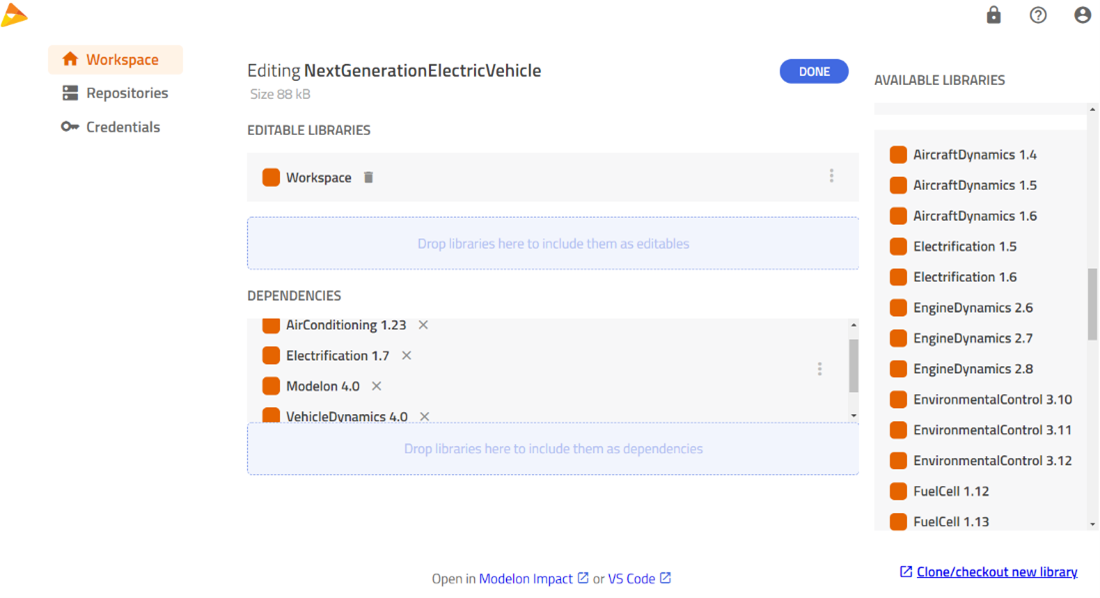
Modelon Impact 2022.1 cloud or on-premise comes with the Workspace Management app, which simplifies collaboration through easy configuration of Modelon Impact workspaces with version controlled libraries, and a possibility to check the status of and interact with these libraries through basic version control operations. The key features enabled by this app are:
- Check out content from Subversion (SVN) or Git
- View information on checked-out content (size on disk, revision, libraries inside, ...)
- See if there are remote updates to checked-out Modelica libraries
- Upload (commit/push) changes to the remote SVN/Git repository
- Configure workspaces with version-controlled content and Modelon Impact libraries
- Credentials store to enable easy access to version-controlled libraries
Note that this functionality is only available in the on-premise or cloud version of Modelon Impact.
Workspace Configuration
- Configure which libraries to use by drag & drop and choose if they should be editable or read-only
- Choose between released or checkout (version-controlled) libraries
Learn: Help Center🔗
Modelon Help Center is Now Available. From getting started to how-to guides and step-by-step tutorials, access comprehensive support resources through the Modelon Help Center. This is now the central resource for anyone (customer or not) to receive self-service help and find answers to their most frequently asked questions.
Platform information🔗
Execution environment🔗
This release include following execution environment.
| Execution environments | v2022.1 |
|---|---|
| Optimica Compiler Toolkit | v1.32 |
| Modelica compliance | v3.4 of Modelica Language specification1 |
| FMU compliance | v2 (default) and v1 |
| Operating system | CentOS v7.4 |
| Python environment | v3.9 |
| C compiler | GCC v4 and glibc v2.17 |
| Execution environments | v2022.1 |
|---|---|
| Optimica Compiler Toolkit | v1.32 |
| Modelica compliance | v3.4 of Modelica Language specification1 |
| FMU compliance | v2 (default) and v1 |
| Operating system | Windows |
| Python environment | v3.7 |
| C compiler | GCC v5.1 |
1 See Optimica Compiler Toolkit User's guide for further information about Modelica compliance and limitations.
Libraries🔗
This release includes following library versions.
| Library | Version |
|---|---|
| AirConditioning | 1.23 |
| AircraftDynamics | 1.6 |
| Electrification | 1.7 |
| EngineDynamics | 2.8 |
| EnvironmentalControl | 3.12 |
| FuelCell | 1.14 |
| FuelSystem | 5.1 |
| HeatExchanger | 2.8 |
| Hydraulics | 4.16 |
| HydroPower | 2.14 |
| IndustryExamples | 1.0 |
| JetPropulsion | 2.4 |
| LiquidCooling | 2.8 |
| Modelon | 4.0 |
| Pneumatics | 2.12 |
| ThermalPower | 1.23 |
| ThermoFluidPro | 1.23 |
| VaporCycle | 2.8 |
| VehicleDynamics | 4.0 |
We hope you like the new functionality and improvements and looking forward to your input!